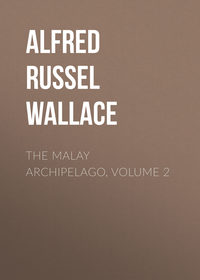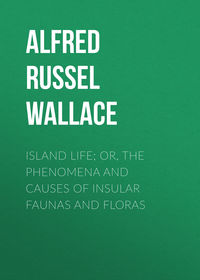 полная версия
полная версияContributions to the Theory of Natural Selection
Females of some Groups require and obtain more Protection than the Males
In the struggle for existence incessantly going on, protection or concealment is one of the most general and most effectual means of maintaining life; and it is by modifications of colour that this protection can be most readily obtained, since no other character is subject to such numerous and rapid variations. The case I have now endeavoured to illustrate is exactly analogous to what occurs among butterflies. As a general rule, the female butterfly is of dull and inconspicuous colours, even when the male is most gorgeously arrayed; but when the species is protected from attack by a disagreeable odour, as in the Heliconidæ, Danaidæ and Acrœidæ, both sexes display the same or equally brilliant hues. Among the species which gain a protection by imitating these, the very weak and slow-flying Leptalides resemble them in both sexes, because both sexes alike require protection, while in the more active and strong-winged genera—Papilio, Pieris, and Diadema—it is generally the females only that mimic the protected groups, and in doing so often become actually more gay and more conspicuous than the males, thus reversing the usual and in fact almost universal characters of the sexes. So, in the wonderful Eastern leaf-insects of the genus Phyllium, it is the female only that so marvellously imitates a green leaf; and in all these cases the difference can be traced to the greater need of protection for the female, on whose continued existence, while depositing her eggs, the safety of the race depends. In Mammalia and in reptiles, however brilliant the colours may be, there is rarely any difference between that of the sexes, because the female is not necessarily more exposed to attack than the male. It may, I think, be looked upon as a confirmation of this view, that no single case is known either in the above-named genera—Papilio, Pieris, and Diadema—or in any other butterfly, of a male alone, mimicking one of the Danaidæ or Heliconidæ. Yet the necessary colour is far more abundant in the males, and variations always seem ready for any useful purpose. This seems to depend on the general law, that each species and each sex can only be modified just as far as is absolutely necessary for it to maintain itself in the struggle for existence, not a step further. A male insect by its structure and habits is less exposed to danger, and also requires less protection than the female. It cannot, therefore, alone acquire any further protection through the agency of natural selection. But the female requires some extra protection, to balance the greater danger to which she is exposed, and her greater importance to the existence of the species; and this she always acquires, in one way or another, through the action of natural selection.
In his “Origin of Species,” fourth edition, p. 241, Mr. Darwin recognises the necessity for protection as sometimes being a cause of the obscure colours of female birds; but he does not seem to consider it so very important an agent in modifying colour as I am disposed to do. In the same paragraph (p. 240), he alludes to the fact of female birds and butterflies being sometimes very plain, sometimes as gay as the males; but, apparently, considers this mainly due to peculiar laws of inheritance, which sometimes continue acquired colour in the line of one sex only, sometimes in both. Without denying the action of such a law (which Mr. Darwin informs me he has facts to support), I impute the difference, in the great majority of cases, to the greater or less need of protection in the female sex in these groups of animals.
This need was seen to exist a century ago by the Hon. Daines Barrington, who, in the article already quoted (see p. 220), after alluding to the fact that singing birds are all small, and suggesting (but I think erroneously) that this may have arisen from the difficulty larger birds would have in concealing themselves if they called the attention of their enemies by loud notes, goes on thus:—“I should rather conceive it is for the same reason no hen bird sings, because this talent would be still more dangerous during incubation, which may possibly also account for the inferiority in point of plumage.” This is a curious anticipation of the main idea on which this essay is founded. It has been unnoticed for near a century, and my attention was only recently called to it by Mr. Darwin himself.
Conclusion
To some persons it will perhaps appear, that the causes to which I impute so much of the external aspect of nature are too simple, too insignificant, and too unimportant for such a mighty work. But I would ask them to consider, that the great object of all the peculiarities of animal structure is to preserve the life of the individual, and to maintain the existence of the species. Colour has hitherto been too often looked upon as something adventitious and superficial, something given to an animal not to be useful to itself, but solely to gratify man or even superior beings—to add to the beauty and ideal harmony of nature. If this were the case, then, it is evident that the colours of organised beings would be an exception to most other natural phenomena. They would not be the product of general laws, or determined by ever-changing external conditions; and we must give up all enquiry into their origin and causes, since (by the hypothesis) they are dependent on a Will whose motives must ever be unknown to us. But, strange to say, no sooner do we begin to examine and classify the colours of natural objects, than we find that they are intimately related to a variety of other phenomena, and are, like them, strictly subordinated to general laws. I have here attempted to elucidate some of these laws in the case of birds, and have shown how the mode of nidification has affected the colouring of the female sex in this group. I have before shown to how great an extent, and in how many ways, the need of protection has determined the colours of insects, and of some groups of reptiles and mammalia, and I would now call particular attention to the fact that the gay tints of flowers, so long supposed to be a convincing proof that colour has been bestowed for other purposes than the good of its possessor, have been shown by Mr. Darwin to follow the same great law of utility. Flowers do not often need protection, but very often require the aid of insects to fertilize them, and maintain their reproductive powers in the greatest vigour. Their gay colours attract insects, as do also their sweet odours and honeyed secretions; and that this is the main function of colour in flowers is shown by the striking fact, that those flowers which can be perfectly fertilized by the wind, and do not need the aid of insects, rarely or never have gaily-coloured flowers.
This wide extension of the general principle of utility to the colours of such varied groups, both in the animal and vegetable kingdoms, compels us to acknowledge that the “reign of law” has been fairly traced into this stronghold of the advocates of special creation. And to those who oppose the explanation I have given of the facts adduced in this essay, I would again respectfully urge that they must grapple with the whole of the facts, not one or two of them only. It will be admitted that, on the theory of evolution and natural selection, a wide range of facts with regard to colour in nature have been co-ordinated and explained. Until at least an equally wide range of facts can be shown to be in harmony with any other theory, we can hardly be expected to abandon that which has already done such good service, and which has led to the discovery of so many interesting and unexpected harmonies among the most common (but hitherto most neglected and least understood), of the phenomena presented by organised beings.
VIII.
CREATION BY LAW
Among the various criticisms that have appeared on Mr. Darwin’s celebrated “Origin of Species,” there is, perhaps, none that will appeal to so large a number of well educated and intelligent persons, as that contained in the Duke of Argyll’s “Reign of Law.” The noble author represents the feelings and expresses the ideas of that large class, who take a keen interest in the progress of Science in general, and especially that of Natural History, but have never themselves studied nature in detail, or acquired that personal knowledge of the structure of closely allied forms,—the wonderful gradations from species to species and from group to group, and the infinite variety of the phenomena of “variation” in organic beings,—which are absolutely necessary for a full appreciation of the facts and reasonings contained in Mr. Darwin’s great work.
Nearly half of the Duke’s book is devoted to an exposition of his idea of “Creation by Law,” and he expresses so clearly what are his difficulties and objections as regards the theory of “Natural Selection,” that I think it advisable that they should be fairly answered, and that his own views should be shown to lead to conclusions, as hard to accept as any which he imputes to Mr. Darwin.
The point on which the Duke of Argyll lays most stress, is, that proofs of Mind everywhere meet us in Nature, and are more especially manifest wherever we find “contrivance” or “beauty.” He maintains that this indicates the constant supervision and direct interference of the Creator, and cannot possibly be explained by the unassisted action of any combination of laws. Now, Mr. Darwin’s work has for its main object, to show, that all the phenomena of living things,—all their wonderful organs and complicated structures, their infinite variety of form, size, and colour, their intricate and involved relations to each other,—may have been produced by the action of a few general laws of the simplest kind, laws which are in most cases mere statements of admitted facts. The chief of these laws or facts are the following:—
1. The Law of Multiplication in Geometrical Progression.—All organized beings have enormous powers of multiplication. Even man, who increases slower than all other animals, could under the most favourable circumstances double his numbers every fifteen years, or a hundred-fold in a century. Many animals and plants could increase their numbers from ten to a thousand-fold every year.
2. The Law of Limited Populations.—The number of living individuals of each species in any country, or in the whole globe, is practically stationary; whence it follows that the whole of this enormous increase must die off almost as fast as produced, except only those individuals for whom room is made by the death of parents. As a simple but striking example, take an oak forest. Every oak will drop annually thousands or millions of acorns, but till an old tree falls, not one of these millions can grow up into an oak. They must die at various stages of growth.
3. The Law of Heredity, or Likeness of Offspring to their Parents.—This is a universal, but not an absolute law. All creatures resemble their parents in a high degree, and in the majority of cases very accurately; so that even individual peculiarities, of whatever kind, in the parents, are almost always transmitted to some of the offspring.
4. The Law of Variation.—This is fully expressed by the lines:—
“No being on this earthly ball,Is like another, all in all.”Offspring resemble their parents very much, but not wholly—each being possesses its individuality. This “variation” itself varies in amount, but it is always present, not only in the whole being, but in every part of every being. Every organ, every character, every feeling is individual; that is to say, varies from the same organ, character, or feeling in every other individual.
5. The Law of unceasing Change of Physical Conditions upon the Surface of the Earth.—Geology shows us that this change has always gone on in times past, and we also know that it is now everywhere going on.
6. The Equilibrium or Harmony of Nature.—When a species is well adapted to the conditions which environ it, it flourishes; when imperfectly adapted it decays; when ill-adapted it becomes extinct. If all the conditions which determine an organism’s well-being are taken into consideration, this statement can hardly be disputed.
This series of facts or laws, are mere statements of what is the condition of nature. They are facts or inferences which are generally known, generally admitted—but in discussing the subject of the “Origin of Species”—as generally forgotten. It is from these universally admitted facts, that the origin of all the varied forms of nature may be deduced by a logical chain of reasoning, which, however, is at every step verified and shown to be in strict accord with facts; and, at the same time, many curious phenomena which can by no other means be understood, are explained and accounted for. It is probable, that these primary facts or laws are but results of the very nature of life, and of the essential properties of organized and unorganized matter. Mr. Herbert Spencer, in his “First Principles” and his “Biology” has, I think, made us able to understand how this may be; but at present we may accept these simple laws without going further back, and the question then is—whether the variety, the harmony, the contrivance, and the beauty we perceive in organic beings, can have been produced by the action of these laws alone, or whether we are required to believe in the incessant interference and direct action of the mind and will of the Creator. It is simply a question of how the Creator has worked. The Duke (and I quote him as having well expressed the views of the more intelligent of Mr. Darwin’s opponents) maintains, that He has personally applied general laws to produce effects, which those laws are not in themselves capable of producing; that the universe alone, with all its laws intact, would be a sort of chaos, without variety, without harmony, without design, without beauty; that there is not (and therefore we may presume that there could not be) any self-developing power in the universe. I believe, on the contrary, that the universe is so constituted as to be self-regulating; that as long as it contains Life, the forms under which that life is manifested have an inherent power of adjustment to each other and to surrounding nature; and that this adjustment necessarily leads to the greatest amount of variety and beauty and enjoyment, because it does depend on general laws, and not on a continual supervision and re-arrangement of details. As a matter of feeling and religion, I hold this to be a far higher conception of the Creator and of the Universe than that which may be called the “continual interference” hypothesis; but it is not a question to be decided by our feelings or convictions, it is a question of facts and of reason. Could the change, which Geology shows us has ever taken place in the forms of life, have been produced by general laws, or does it imperatively require the incessant supervision of a creative mind? This is the question for us to consider, and our opponents have the difficult task of proving a negative, if we show that there are both facts and analogies in our favour.
Mr. Darwin’s Metaphors liable to Misconception
Mr. Darwin has laid himself open to much misconception, and has given to his opponents a powerful weapon against himself, by his continual use of metaphor in describing the wonderful co-adaptations of organic beings.
“It is curious,” says the Duke of Argyll, “to observe the language which this most advanced disciple of pure naturalism instinctively uses, when he has to describe the complicated structure of this curious order of plants (the Orchids). ‘Caution in ascribing intentions to nature,’ does not seem to occur to him as possible. Intention is the one thing which he does see, and which, when he does not see, he seeks for diligently until he finds it. He exhausts every form of words and of illustration, by which intention or mental purpose can be described. ‘Contrivance’—‘curious contrivance,’—‘beautiful contrivance,’—these are expressions which occur over and over again. Here is one sentence describing the parts of a particular species: ‘the Labellum is developed into a long nectary, in order to attract Lepidoptera, and we shall presently give reason for suspecting that the nectar is purposely so lodged, that it can be sucked only slowly in order to give time for the curious chemical quality of the viscid matter setting hard and dry.’” Many other examples of similar expressions are quoted by the Duke, who maintains that no explanation of these “contrivances” has been or can be given, except on the supposition of a personal contriver, specially arranging the details of each case, although causing them to be produced by the ordinary processes of growth and reproduction.
Now there is a difficulty in this view of the origin of the structure of Orchids which the Duke does not allude to. The majority of flowering plants are fertilized, either without the agency of insects or, when insects are required, without any very important modification of the structure of the flower. It is evident, therefore, that flowers might have been formed as varied, fantastic, and beautiful as the Orchids, and yet have been fertilized without more complexity of structure than is found in Violets, or Clover, or Primroses, or a thousand other flowers. The strange springs and traps and pitfalls found in the flowers of Orchids cannot be necessary per se, since exactly the same end is gained in ten thousand other flowers which do not possess them. Is it not then an extraordinary idea, to imagine the Creator of the Universe contriving the various complicated parts of these flowers, as a mechanic might contrive an ingenious toy or a difficult puzzle? Is it not a more worthy conception that they are some of the results of those general laws which were so co-ordinated at the first introduction of life upon the earth as to result necessarily in the utmost possible development of varied forms?
But let us take one of the simpler cases adduced and see if our general laws are unable to account for it.
A Case of Orchis-structure explained by Natural Selection
There is a Madagascar Orchis—the Angræcum sesquipedale—with an immensely long and deep nectary. How did such an extraordinary organ come to be developed? Mr. Darwin’s explanation is this. The pollen of this flower can only be removed by the base of the proboscis of some very large moths, when trying to get at the nectar at the bottom of the vessel. The moths with the longest probosces would do this most effectually; they would be rewarded for their long tongues by getting the most nectar; whilst on the other hand, the flowers with the deepest nectaries would be the best fertilized by the largest moths preferring them. Consequently, the deepest nectaried Orchids and the longest tongued moths would each confer on the other an advantage in the battle of life. This would tend to their respective perpetuation, and to the constant lengthening of nectaries and probosces. Now let it be remembered, that what we have to account for, is only the unusual length of this organ. A nectary is found in many orders of plants and is especially common in the Orchids, but in this one case only is it more than a foot long. How did this arise? We begin with the fact, proved experimentally by Mr. Darwin, that moths do visit Orchids, do thrust their spiral trunks into the nectaries, and do fertilize them by carrying the pollinia of one flower to the stigma of another. He has further explained the exact mechanism by which this is effected, and the Duke of Argyll admits the accuracy of his observations. In our British species, such as Orchis pyramidalis, it is not necessary that there should be any exact adjustment between the length of the nectary and that of the proboscis of the insect; and thus a number of insects of various sizes are found to carry away the pollinia and aid in the fertilization. In the Angræcum sesquipedale, however, it is necessary that the proboscis should be forced into a particular part of the flower, and this would only be done by a large moth burying its proboscis to the very base, and straining to drain the nectar from the bottom of the long tube, in which it occupies a depth of one or two inches only. Now let us start from the time when the nectary was only half its present length or about six inches, and was chiefly fertilized by a species of moth which appeared at the time of the plant’s flowering, and whose proboscis was of the same length. Among the millions of flowers of the Angræcum produced every year, some would always be shorter than the average, some longer. The former, owing to the structure of the flower, would not get fertilized, because the moths could get all the nectar without forcing their trunks down to the very base. The latter would be well fertilized, and the longest would on the average be the best fertilized of all. By this process alone the average length of the nectary would annually increase, because, the short-nectaried flowers being sterile and the long ones having abundant offspring, exactly the same effect would be produced as if a gardener destroyed the short ones and sowed the seed of the long ones only; and this we know by experience would produce a regular increase of length, since it is this very process which has increased the size and changed the form of our cultivated fruits and flowers.
But this would lead in time to such an increased length of the nectary that many of the moths could only just reach the surface of the nectar, and only the few with exceptionally long trunks be able to suck up a considerable portion.
This would cause many moths to neglect these flowers because they could not get a satisfying supply of nectar, and if these were the only moths in the country the flowers would undoubtedly suffer, and the further growth of the nectary be checked by exactly the same process which had led to its increase. But there are an immense variety of moths, of various lengths of proboscis, and as the nectary became longer, other and larger species would become the fertilizers, and would carry on the process till the largest moths became the sole agents. Now, if not before, the moth would also be affected, for those with the longest probosces would get most food, would be the strongest and most vigorous, would visit and fertilize the greatest number of flowers, and would leave the largest number of descendants. The flowers most completely fertilized by these moths being those which had the longest nectaries, there would in each generation be on the average an increase in the length of the nectaries, and also an average increase in the length of the probosces of the moths; and this would be a necessary result from the fact that nature ever fluctuates about a mean, or that in every generation there would be flowers with longer and shorter nectaries, and moths with longer and shorter probosces than the average. No doubt there are a hundred causes that might have checked this process before it had reached the point of development at which we find it. If, for instance, the variation in the quantity of nectar had been at any stage greater than the variation in the length of the nectary, then smaller moths could have reached it and have effected the fertilization. Or if the growth of the probosces of the moths had from other causes increased quicker than that of the nectary, or if the increased length of proboscis had been injurious to them in any way, or if the species of moth with the longest proboscis had become much diminished by some enemy or other unfavourable conditions, then, in any of these cases, the shorter nectaried flowers, which would have attracted and could have been fertilized by the smaller kinds of moths, would have had the advantage. And checks of a similar nature to these no doubt have acted in other parts of the world, and have prevented such an extraordinary development of nectary as has been produced by favourable conditions in Madagascar only, and in one single species of Orchid. I may here mention that some of the large Sphinx moths of the tropics have probosces nearly as long as the nectary of Angræcum sesquipedale. I have carefully measured the proboscis of a specimen of Macrosila cluentius from South America, in the collection of the British Museum, and find it to be nine inches and a quarter long! One from tropical Africa (Macrosila morganii) is seven inches and a half. A species having a proboscis two or three inches longer could reach the nectar in the largest flowers of Angræcum sesquipedale, whose nectaries vary in length from ten to fourteen inches. That such a moth exists in Madagascar may be safely predicted; and naturalists who visit that island should search for it with as much confidence as Astronomers searched for the planet Neptune,—and I venture to predict they will be equally successful!









